Is Waymo more expensive than Uber?

You might expect a self-driving Jaguar to cost more than an Uber. But a recent Waymo ride in Los Angeles showed otherwise, and a recent TikTok clip raises the question of what’s behind the price difference.
Parpude (@parpude), a TikToker and at least fairly frequent San Francisco resident, asked the question in a clip filmed during a recent Waymo ride in Los Angeles. Her caption says similar trips cost more in the Bay Area, leaving her curious about the economic and market forces at play.
Waymo in Los Angeles
Waymo has begun offering fully autonomous commercial rides in several U.S. cities through its “Waymo One” program. The company uses the fully electric Jaguar I‑PACE as one of its main robotaxi vehicles, thanks to a strategic partnership with Jaguar Land Rover dating back to 2018.
According to Waymo, approximately 1,500 of these I-PACE vehicles are currently in service in San Francisco, Los Angeles, Phoenix and Austin, with plans to add more than 2,000 additional units by 2026. In Los Angeles, this means a driverless electric vehicle is a real option for today’s consumers.
Parpude’s surprise ride highlights an apparent contradiction: How can a ride in a driverless luxury electric vehicle cost less, or at least be competitive with the standard ride-sharing services of Uber or Lyft? Several factors contribute to explaining this.
Operationally, Waymo’s cost base differs: no human driver wages, fewer tipping and scheduling variables, and an electric platform that eliminates fuel costs. The Jaguar I-PACE is a premium electric vehicle, and Waymo’s blog emphasizes its integration of sensors and computing into this platform. Additionally, promotional and market entry pricing may influence local rate levels in Los Angeles. Independent testing in Los Angeles found examples where a Waymo ride cost about $20 for 17 minutes, which in one case was about $6 cheaper than Uber or Lyft for a similar route.
Viral Stories on the Web
Our team of experts tracks what owners are saying about car buying, repairs, daily driving experience and more on social media.
There’s also the issue of local supply and demand: If Waymo has enough vehicles in the area and less need to increase traffic, it could set a lower base rate to increase ridership and fine-tune its operations.
While Parpude’s TikTok journey suggests Waymo could beat Uber on price in Los Angeles, other studies paint a broadly different picture. For example, a sample of about 90,000 offers in San Francisco found that the average Waymo ride was about $20.43, compared to $15.58 for Uber and $14.44 for Lyft. This translated to a premium of 31% and 41%, respectively. This same data showed that the gap widens during peak hours.
Another analysis looking specifically at Los Angeles found that for some short distances, UberX averaged about $23.81 for a 6.3-mile trip, while Waymo averaged $23.09 for the same distance.
So while local cases like the TikTok ride may show Waymo undercutting, these are likely situational: prices depend heavily on location, time of day, route length, and vehicle availability.
User experience and perception
From a rider’s perspective, Waymo’s appeal is not just cost but also novelty, perceived quality, and the EV/driverless factor. Rider reports are mixed, although some highlight the smoothness, quietness and predictability of a robotaxi, particularly if it’s built on an electric platform like the Jaguar I-PACE.
Waymo’s use of the Jaguar I-PACE and driverless technology demonstrates how electric vehicles can become the backbone of new transportation services. The actual pricing structure tells us a lot about how electric vehicles and autonomy could reshape cost structures in the future.
If driverless electric vehicles can offer prices comparable to or lower than human-piloted services at scale, the economics of mobility will change. This could accelerate consumers’ exposure to electric vehicles as drivers, not just buyers, influencing fleet purchasing decisions and raising questions about how traditional rideshares scale.
The fact that many studies show Waymo is even more expensive in some markets indicates that driverless electric vehicles don’t always command the lowest fares. Factors such as fleet scale, map coverage, regulatory costs, location of operations and vehicle depreciation are all important.
The TikTok clip captured a surprise moment during a driverless electric vehicle ride in Los Angeles that undercut Uber, but the bigger picture is more nuanced. Whether Waymo is still cheaper than Uber depends greatly on the market and route.
For electric vehicle watchers, the question to watch is: As Waymo and others scale their fleets and expand into more cities, will these cost advantages become the rule rather than the exception? If so, the next time someone boards a robo-taxi, the price shock might wear off, but the technology will have already changed the game.
InsideEVs reached out to Parpude via instant message and comment on the clip. We’ll be sure to update this if they respond.




